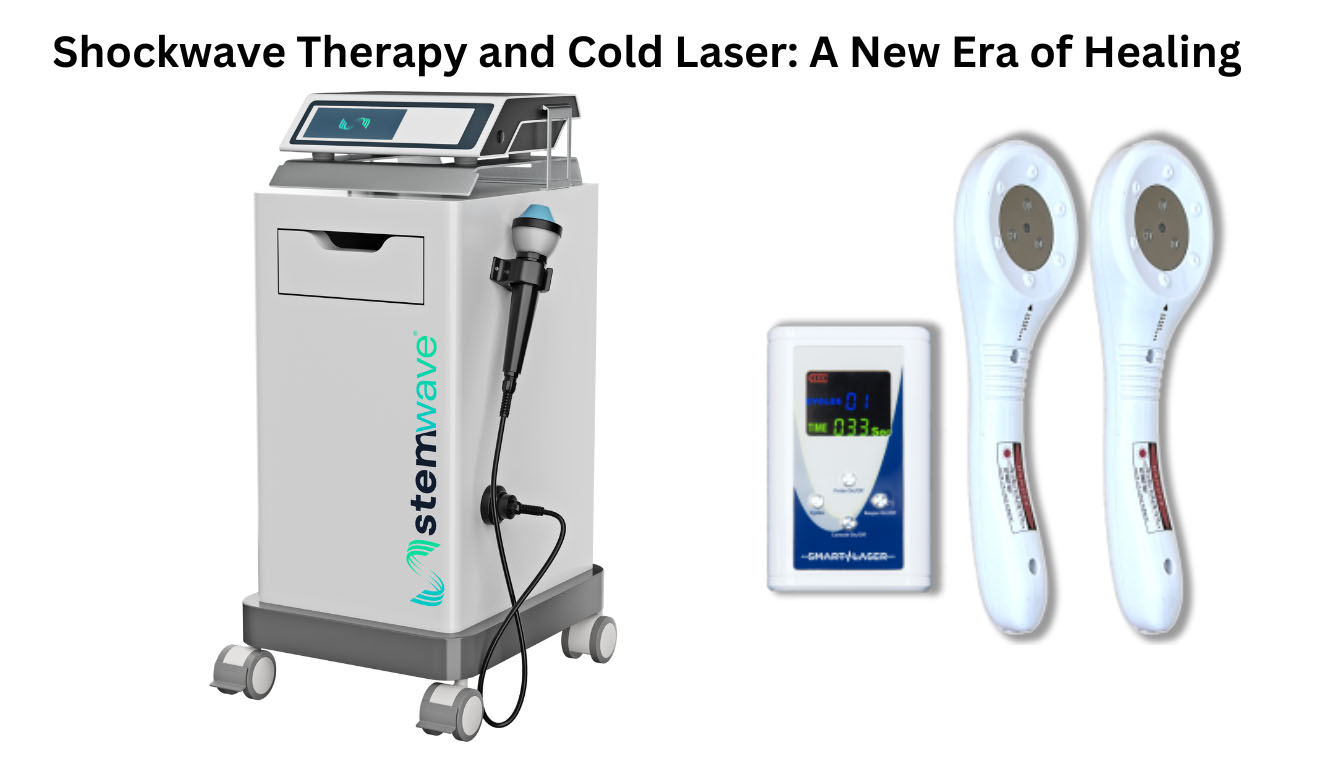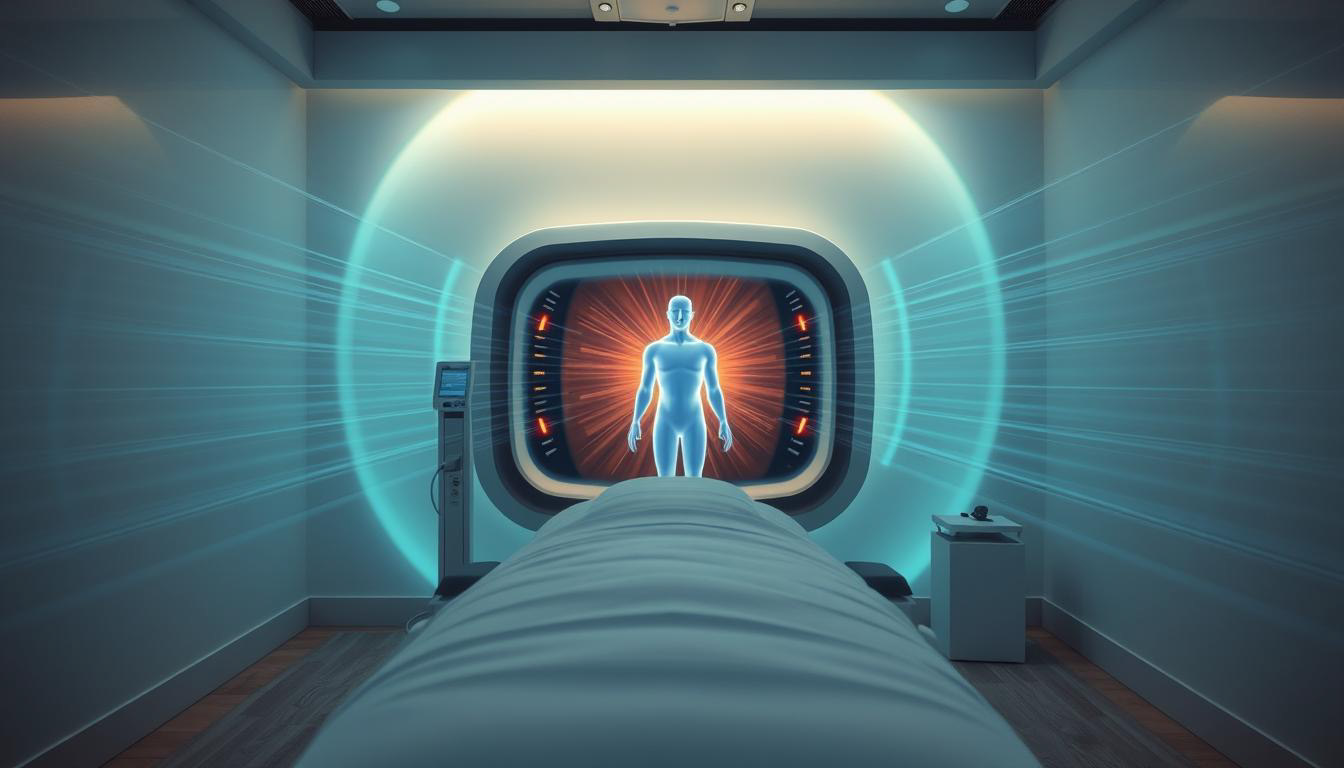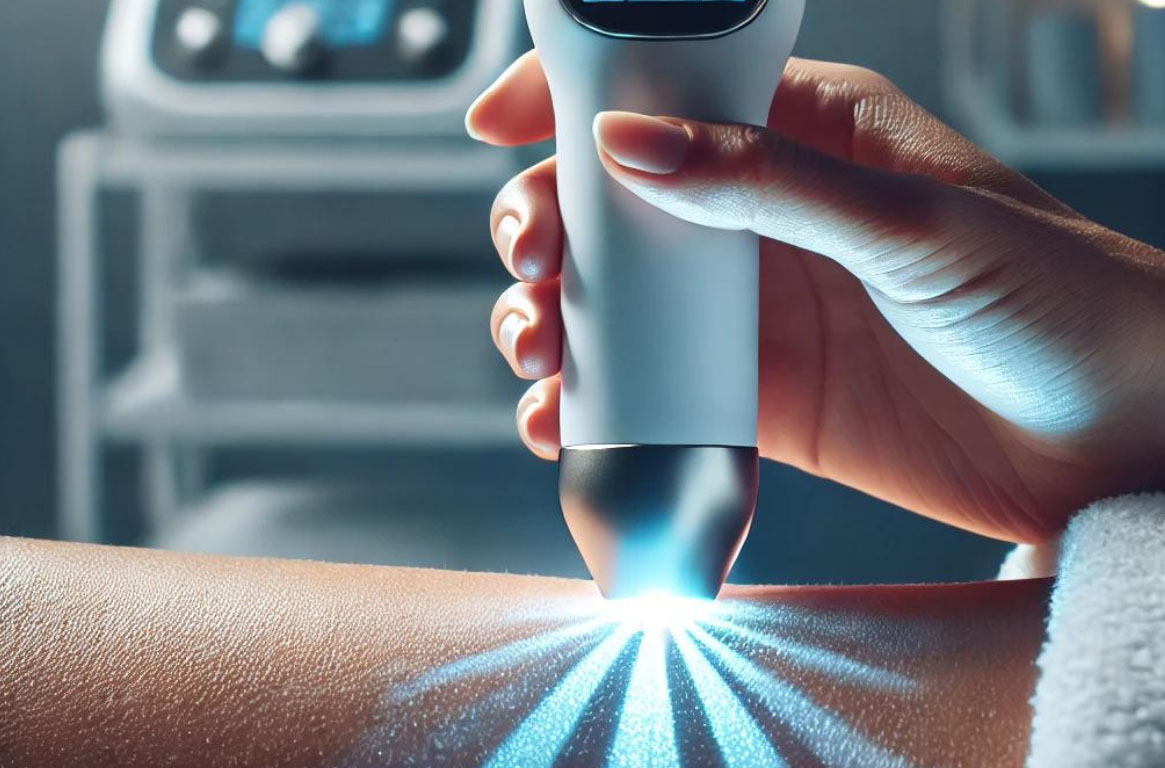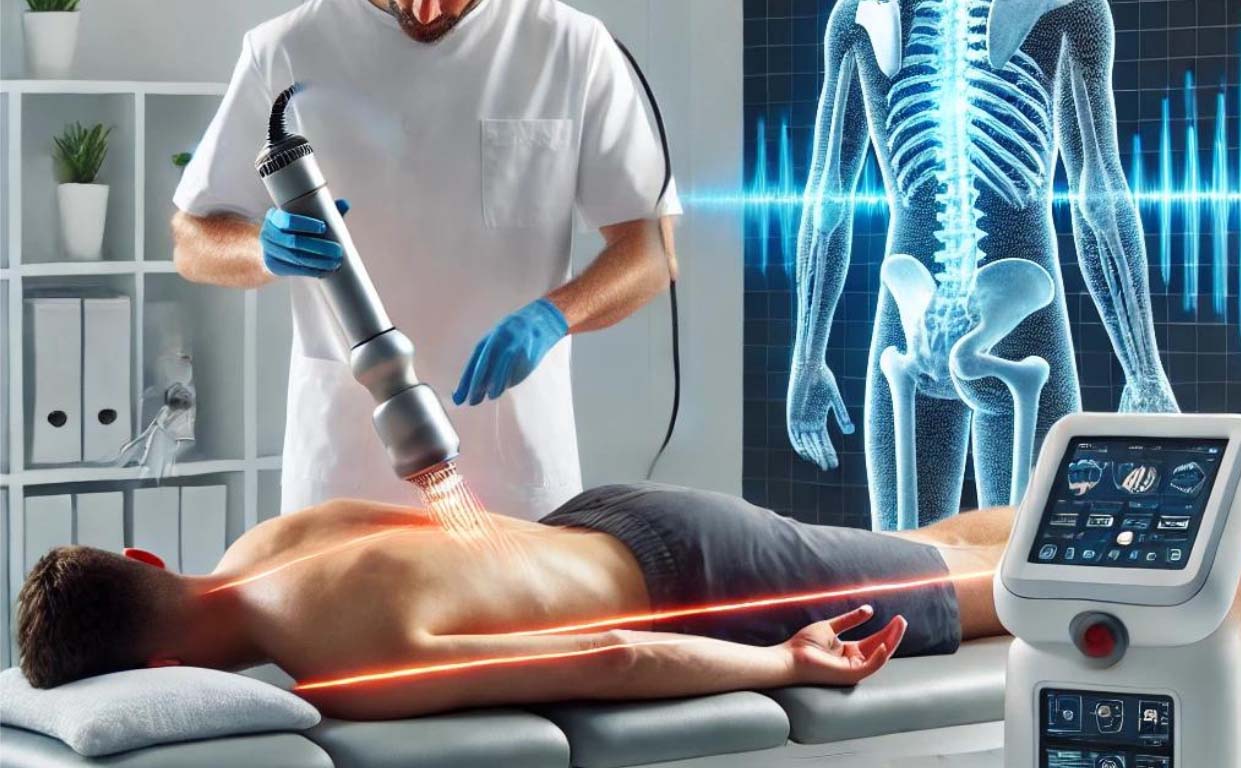
Shockwave therapy and cold laser treatments are changing the game in pain management and healing. These non-invasive methods are making a big impact in treating musculoskeletal issues like frozen shoulder, biceps tendinopathy, lateral epicondylitis, knee osteoarthritis and plantar fasciitis. Using sound waves from shockwave therapy and cold laser energy to help the body heal faster, reduce pain and get active again.
This article will explore how shockwave therapy and cold laser therapy work. We'll look at their uses and how they can be used together. Get ready to learn about the latest in pain management and healing, where new technologies are making a big difference in patient care.
Imagine a world where pain no longer holds you back—a world where healing is fast, effective, and doesn’t rely on invasive procedures or endless medications. Whether it's a nagging injury, chronic discomfort, or post-surgery recovery, many people are tired of relying on temporary fixes that don’t address the root of the issue. Fortunately, revolutionary advancements like shockwave therapy and cold laser treatments are offering a new, powerful solution for long-lasting relief. If you're seeking pain relief that actually promotes healing, you're about to discover the next generation of therapies.
Shockwave therapy and cold laser have quickly become two of the most sought-after treatments for conditions like plantar fasciitis, tendinitis, and muscle injuries. Shockwave therapy uses targeted acoustic waves to stimulate the body’s natural healing process, breaking down scar tissue, improving blood flow, and speeding up recovery. Meanwhile, cold laser therapy uses low-level light to penetrate deep into tissues, reducing inflammation and accelerating cellular repair. Together, these therapies don't just mask pain—they help your body heal itself from within.
What sets these therapies apart is not just their effectiveness, but the minimal risk and downtime involved. No surgery, no strong medications—just scientifically backed treatments that deliver results. Whether you're an athlete, a busy professional, or someone simply looking to live pain-free, shockwave and cold laser therapy can be the game-changing solutions you've been searching for. Curious if it's the right fit for you? You might be just one treatment away from saying goodbye to chronic pain for good.

Key Takeaways
- Shockwave therapy and cold laser therapy are innovative, non-invasive treatments that are transforming the field of pain management and tissue healing. More and more chiropractors, physical therapist offices and orthopedic doctors are using these modalities as alternatives to Cortisone shots and surgery.
- These advanced modalities harness the power of sound waves and low-level laser energy to effectively reduce pain, decrease inflammation, and accelerate the body's natural healing process.
- By understanding the mechanisms of action and clinical applications of shockwave therapy and cold laser therapy, healthcare professionals can offer their patients cutting-edge solutions for a wide range of musculoskeletal conditions.
- The synergistic benefits of combining shockwave therapy and cold laser therapy can lead to even more impressive outcomes, making these treatments a game-changer in the field of pain management and rehabilitation. For patients suffering with chronic pain and injuries that are not responding to any other treatments, ESWT and Cold Laser might be exactly what they are looking for.
- Advancements in technology and treatment protocols are continuously improving the efficacy and accessibility of these innovative therapies, paving the way for a new era of holistic and effective patient care.
Tendinopathy: Prevalence and Impact
Tendinopathy is a common musculoskeletal disorder that causes pain and limits movement. It affects many people and can greatly reduce their quality of life. Studies have shown how widespread tendinopathy is in different groups.
A study in the BMC Musculoskeletal Disorders journal found that tendinopathies in the lower limbs were common in Denmark. Another study found that elite athletes often suffer from Achilles and patellar tendinopathy, with rates reaching up to 45%. Tendinopathy not only limits physical activities but also affects daily life and can be costly.
Insights from Research Studies
Many studies have looked into tendinopathy's prevalence and effects. They offer important insights:
- A systematic review and meta-analysis found that patellar tendinopathy affects 8.5% of athletes and the general population.
- A study on team sports over 8 seasons found a tendinopathy incidence rate of 1.4 per 1,000 athlete-exposures.
- Research on junior basketball players aged 14-18 found a 14% prevalence of patellar tendinopathy.
It's important to understand tendinopathy's scope and effects. This knowledge helps in finding new treatments for this widespread condition. The most common tendinopathies we see in our office, says Dr. Hamel of Hamel Chiropractic and Wellness, are biceps tendinopathy, tennis elbow, golfer's elbow, Achilles tendinopathy, rotator cuff tendinopathy, and patellar tendinopathy, (Jumper's Knee)
Conventional Treatment Approaches: Limitations and Risks
Traditional treatments for tendinopathy often don't last long. Non-steroidal anti-inflammatory drugs (NSAIDs) are common but can cause NSAID side effects. These include stomach problems, kidney issues and heart risks. What many people suffering with chronic pain or arthritis don't realize, is that long-term use of NSAIDS also slows down tendon healing.
Physical therapy can help with pain, but it doesn't fix the tendon problems. This means patients might still face tendinopathy treatments risks like pain coming back, or range of motion issues in the area they are treating. Doctors are now looking for better, safer ways to treat tendinopathy.
|
Conventional Tendinopathy Treatments |
Limitations and Risks |
|
NSAIDs (Non-Steroidal Anti-Inflammatory Drugs) |
|
|
Conservative Therapies (e.g., Physical Therapy) |
|
There's a big push for new, safer treatments for tendinopathy. This has led to looking into things like shockwave therapy and cold laser therapy. These might offer better results for patients without the side effects of taking medicine, or Cortisone shots.

Cold Laser Therapy: A Promising Alternative
Cold laser therapy, also known as low-level laser therapy (LLLT), is a new way to treat tendinopathy, arthritis, nerve pain, heel spurs and other musculoskeletal problems. It uses low-intensity laser light that goes deep into the tissue without causing heat damage. This action helps injuries heal, reduce inflammation, and ease pain.
Mechanisms and Benefits of Low-Level Laser Therapy (LLLT)
Studies show LLLT can help with inflammation, tissue repair, and collagen production. It also helps with chronic pain. This makes it a great option for treating tendinopathy, muscle spasm, headaches and even fibromyalgia. It's safe and doesn't have side effects, both the patient and doctor are on board with this.
- Cold laser therapy is used by doctors, dentists, chiropractors, physical therapists, and other medical professionals for tissue repair and pain relief.
- It is commonly used in sports medicine and physical therapy for treating conditions such as ligament sprains, muscle strains, tendonitis, bursitis, and other minor injuries.
- Cold laser therapy is effective in wound healing, particularly challenging wounds related to diabetes.
- Researchers are exploring new applications for cold laser therapy, including its potential to treat traumatic brain injury (TBI), spinal cord injury, Alzheimer's disease, and Parkinson's disease.
Cold laser therapy is safe and effective. It can reduce pain and help tissues heal. This makes it a great alternative for treating tendinopathy and other muscle issues. Most doctors and providers who are providing cold laser therapy are using it to enhance healing and repair for musculoskeletal injuries and conditions. If inquiring about using cold laser for brain injuries, spinal cord injuries, Alzheimer's or Parkinsons definitely reach out to a specialist.

Shockwave Therapy: A Breakthrough in Treatment
Shockwave therapy, also known as extracorporeal shockwave therapy (ESWT), is a new way to treat musculoskeletal issues like tendinopathy. It uses high-energy sound waves to help heal damaged tissues and reduce pain. This therapy works by starting the body's healing process. It helps create new blood vessels and releases growth factors. This leads to better tendon repair and less pain. Studies show that shockwave therapy is very effective. It helps patients feel better quickly and move more easily. It's a big help for those with tendinopathies, arthritis, fasciitis, tendon tears and even neuropathies.
Shockwave therapy is also non-invasive and treats joint and soft tissue injuries without surgery. This makes it a great option for sports medicine doctors, chiropractor and physical therapists offices to use with their patients.
It's not just for tendinopathy. shockwave therapy can also help with other muscle and bone issues. These include:
- Shoulder tendinopathy
- Lateral epicondylosis/epicondylitis
- Greater trochanteric pain syndrome
- Hamstring tendinopathy
- Patellar tendinopathy
- Medial tibial stress syndrome
- Achilles tendinopathy
- Plantar fasciitis
- Knee osteoarthritis
- Fracture nonunion
- Spasticity of spinal and supraspinal origin
Shockwave therapy is changing how we treat muscle, nerve and bone problems. It's a safe and effective way to enhance the body's healing by bringing in oxygen, and reducing inflammation. This opens up new possibilities for treating injuries, this procedure can be done in a chiropractor’s office, there is no need for a referral or medicine.
Combining Shockwave and Cold Laser Therapies
The mix of combining shockwave and cold laser could change how we treat many muscle and bone problems. By using both, doctors can get better results in a shorter period of time for their patients. This is because each therapy has its own special benefits.
Synergistic Effects and Clinical Outcomes
Shockwave therapy helps the body heal itself. When paired with shockwave and LLLT, it gets even better. This combo tackles tendinopathy, osteoarthritis, bursitis and other soft tissue injuries. Both treatments are non-invasive, have little to no side effects and they don't require a lot of time; you can combine a shockwave therapy and cold laser session together in about 15-20 minutes. There is no downtime after the procedure; patients leave the office and return to their regular daily activities. Studies show that using both shockwave and cold laser together works best. Patients experience less pain, more mobility, and heal faster.
|
Condition |
Effectiveness of Combined Therapy |
|
Plantar Fasciitis |
Effective |
|
Lateral Epicondylitis |
Effective |
|
Greater Trochanter Pain Syndrome |
Effective |
|
Chronic Plantar Fasciitis |
Effective |
|
Chronic Medial Tibial Stress Syndrome |
Effective |
|
Achilles Tendinopathy |
Effective |
A study mixed shockwave therapy (120 mJ, 2000 pulses) with Apollo Class IV laser (350 Joules). It helped a patient with knee pain a lot after just one treatment. The patient felt better and slept better too. More and more doctors, physical therapists and chiropractors are trying new treatments like shockwave and cold laser therapies to get their patients active and pain free quickly and without medicine.
Advancements in Technology and Treatment Protocols
The field of shockwave therapy and cold laser therapy is always changing. New advancements in technology and treatment protocols are being developed. New materials in cold laser devices now reach deeper tissues like the meniscus, cartilage, tendons, ligaments and fascia. Shockwave therapy has also become more precise and effective, providers are using the latest research to create treatment plans that fit each patient's needs.
|
Advancements in Shockwave Therapy |
Advancements in Cold Laser Therapy |
|
|
These technological innovations and treatment protocols have greatly improved shockwave therapy and cold laser therapy. They help treat many musculoskeletal conditions in a non-invasive way which many patients are preferring these days.
"The future of musculoskeletal care lies in the seamless integration of advanced therapeutic technologies like shockwave therapy and cold laser therapy, coupled with personalized treatment protocols that cater to the unique needs of each patient."
Integrating Advanced Therapies into Clinical Practice
Healthcare providers, chiropractors, physical therapists and orthopedic doctors are now using shockwave and cold laser therapy more often. Make sure to go see a reputable shockwave therapy provider that has the right training and right equipment. The top choices for shockwave therapy equipment are StemWave and Softwave, for cold laser therapy choose Microlight corporation. By adding these advanced therapies to their treatment, healthcare providers can give patients the best care, this puts their clinics at the leading edge of healthcare today.
Key Steps for Doctors Integrating Advanced Therapies
- Provide comprehensive training for healthcare providers on the proper application of shockwave therapy and cold laser therapy
- Invest in high-quality shockwave and cold laser devices to ensure optimal treatment outcomes. Shockwave therapy units from StemWave are close to $60,000, Microlight cold lasers can be around $8000. Trying to buy cheap, inexpensive versions of these online will get you nowhere; you definitely get what you pay for when it comes to these cutting-edge therapeutic devices.
- Providers using shockwave therapy and cold laser treatments develop streamlined treatment protocols that integrate these advanced modalities into the clinical workflow. Most treatment protocols will be 6-8 weeks to allow healing to take place.
- These medical doctors, chiropractors and physical therapists stay up-to-date with the latest research, continuing education and advancements in shockwave and cold laser therapy.
- It is the responsibility of the providers to educate patients on the benefits and safety of these innovative therapies. People with chronic aches and pains are really starting to search online for shockwave therapy and cold laser therapy as an alternative to getting more pain shots or not wanting to get surgery.
"The integration of shockwave therapy and cold laser therapy into our clinical practice has been a game-changer, allowing us to provide our patients with the most innovative and effective treatments available."
Conclusion
As we wrap up our exploration of shockwave therapy and cold laser therapy, it's evident that they're changing the game in musculoskeletal care. These new methods help tackle the challenges of tendinopathy, offering better solutions than traditional treatments. They show great promise in improving patient care. Using these therapies together can make treatments more effective and tailored to each patient. As technology gets better and treatment plans evolve, using shockwave and cold laser therapy will be key. It will help offer the latest, safest, and most effective care for injury recovery whether it be for athletes, car accident patients, weekend warriors or people who just don't want to get surgery.
The future looks bright for these advanced therapies in musculoskeletal care. By keeping up with these advancements, alternative minded doctors can provide their patients the best and most effective care. This leads to better health outcomes and a higher quality of life for them.
FAQ
What is shockwave therapy?
Shockwave therapy is a non-invasive treatment. It uses high-energy sound waves to help boost the body's ability to heal and repair naturally. Extracorporeal shockwave therapy helps reduce inflammation, improve circulation and bring healing cells into the injured area. Significant improvement has been shown in conditions such as frozen shoulder, knee osteoarthritis, plantar fasciitis, Achilles tendinitis and tennis elbow.
How does cold laser therapy work?
Cold laser therapy uses low-intensity laser light. This light goes deep into the injured tissue and triggers healing, reduces inflammation, and eases pain. It enhances the body's healing and repair mechanisms by using photo-stimulation with specific wavelengths. It is cold laser therapy so there is no risk for burns or damaging tissues with heat.
What are the benefits of combining shockwave therapy and cold laser therapy?
Combining these therapies can improve treatment results. It can lead to more pain relief, better function, and faster healing. We use the combination of these therapies, says Dr. Hamel, to help speed up the recovery process. These days, patients want to get better quickly; they don't want to be injured and inactive for months; they want to be better today. The powerful combination of these two modalities helps to significantly reduce inflammation, increases microcirculation, increases collagen production, increased cell metabolism, enhances nerve regeneration and improves enzyme response.
How prevalent is tendinopathy, and what are the impacts?
Tendinopathy is common and affects many people's lives. Studies show it's found in up to 45% of elite athletes. It can make daily activities very difficult and these athletes can be on the sidelines because of the severity of the pain. Tendinopathies, if not treated correctly, can lead to tears and more severe injuries down the road.
What are the limitations and risks of conventional tendinopathy treatments?
Traditional treatments have big drawbacks. Medications and anti-inflammatories can harm the stomach and don't always heal the tendon. Conservative therapies don't seem to work as well as ESWT and Cold Laser therapy.
How are advancements in technology and treatment protocols improving shockwave therapy and cold laser therapy?
New technology is making these therapies better. Devices can now reach deeper and work more precisely. Doctors are also getting better at tailoring treatments to each patient and their specific injuries.
How long does it take to heal tendinopathies and other soft tissue injuries?
If the body is healthy and gets the right kind of therapy; it can lay down new collagen fibers and healthy tissue in around 6-8 weeks. Going through the treatment protocol with shockwave therapy and cold laser can enhance the healing process and make sure you are fully recovered before getting back to work, working out or your sport. In the times span of 6-8 weeks, expect to get treatment twice a week for 10-12 visits. The only other recommendation is to not irritate your injury during this healing process; you have to let the body rest. You will be able to do certain light exercises or stretches, but none that will make your injury worse or slow down healing time.
Where do I find cold laser therapy near me?
You can reach out to a cold laser company like Microlight corp to see if they have providers in your area. Like shockwave therapy, it is mostly alternative doctors who are using cold laser therapy such as chiropractors, physical therapists, sports medicine doctors and orthopedic doctors. Search google to see if there are providers in your area and look at their google reviews to see how patients are responding to treatments. You can also ask friends, your primary care doctor or a trainer at the gym; they may know a doctor in the area providing cold laser therapy.
How does low level laser therapy, (LLLT), actually work?
While the full effects of low-level laser therapy (LLLT) aren't entirely understood, studies show it helps boost circulation and reduce pain in several ways. These include lowering blood pressure, widening blood vessels (vasodilation), boosting capillary circulation, and increasing the body's natural painkillers like endorphins. LLLT also speeds up healing and relieves pain by slowing down the sensory nerves responsible for pain signals. Its effectiveness is even greater when combined with shockwave therapy to naturally help heal and repair damage tissues.
Source Links
- https://www.ncbi.nlm.nih.gov/pmc/articles/PMC5025921/
- https://josr-online.biomedcentral.com/articles/10.1186/s13018-023-04141-5
- https://alignwc.com/what-is-shockwave-therapy/
- https://www.ncbi.nlm.nih.gov/pmc/articles/PMC10713145/
- https://www.ncbi.nlm.nih.gov/pmc/articles/PMC11041007/
- https://bmcmusculoskeletdisord.biomedcentral.com/articles/10.1186/s12891-024-07445-7
- https://www.ncbi.nlm.nih.gov/pmc/articles/PMC6029898/
- https://statelinechirocenter.com/comparing-shockwave-therapy-to-traditional-pain-treatment-methods/
- https://utswmed.org/medblog/sports-injuries-shockwave-therapy/
- https://www.healthline.com/health/cold-laser-therapy
- https://softwaveclinics.com/blog/shockwave-vs-laser-therapy/
- https://softwaveclinics.com/blog/shockwave-vs-laser-for-plantar-fasciitis/
- https://www.mayoclinic.org/medical-professionals/physical-medicine-rehabilitation/news/the-evolving-use-of-extracorporeal-shock-wave-therapy-in-managing-musculoskeletal-and-neurological-diagnoses/mac-20527246
- https://www.ncbi.nlm.nih.gov/pmc/articles/PMC9321712/
- https://cospineandjoint.com/shockwave-therapy-knee-pain-treatment/
- https://www.apollopt.com/learn/blog/cold-laser-and-shockwave-therapy-going-beyond-the-research.aspx
- https://simplyalignrehab.com/physiotherapy/shockwave-with-class-4-laser/
- https://www.ncbi.nlm.nih.gov/pmc/articles/PMC2923385/
- https://www.ncbi.nlm.nih.gov/pmc/articles/PMC8944950/
- https://tyranceorthopedics.com/revolutionizing-rider-wellness-with-advanced-therapies/
- https://www.ncbi.nlm.nih.gov/pmc/articles/PMC8869515/
- https://www.ncbi.nlm.nih.gov/pmc/articles/PMC7275282/
- https://josr-online.biomedcentral.com/articles/10.1186/1749-799X-7-11
- https://www.scielo.br/j/aob/a/vXbMgykdY4spFLfHWkFM7cq/?lang=en

